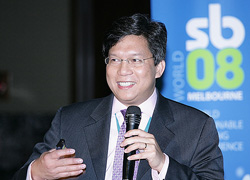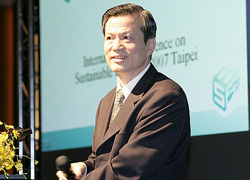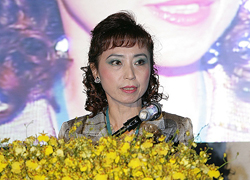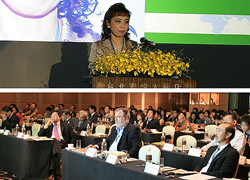Summary of SB07 Taipei International Conference(2)
|
SB07 Taipei國際會議紀要(2)  結束午餐後隨即展開第三全會,由SB08Melbourne 聯席主席Dr. Greg Foliente發表 「超越『三重底線』與『綠建築』─邁向永續未來」之專題演講,為協調永續發展的整體與綜合研究,內容中提到我們為何在規劃、設計、管理與評估時必須超越三元兼顧而著眼於多元兼顧,同時將目標與焦點擴及都市永續性,而非僅局限於設計與建造單一綠建築時造成的較小影響。這表示適用於由產品到整體建築系統到物件組合,以至於都市區域的整合式永續性規劃與評估,應包含永續效能指標與評估方法。身為人類居住與消耗的中心,城市可說是有效永續性變革的關鍵,變革必須短期可見實質收益─亦即類似「引爆點」現象─而非逐漸增加。藉由趨成導向達成持續的製程和產品革新,因而得以呈現有助於社會變革邁向都市永續性的成果概念、利益和應用。 結束午餐後隨即展開第三全會,由SB08Melbourne 聯席主席Dr. Greg Foliente發表 「超越『三重底線』與『綠建築』─邁向永續未來」之專題演講,為協調永續發展的整體與綜合研究,內容中提到我們為何在規劃、設計、管理與評估時必須超越三元兼顧而著眼於多元兼顧,同時將目標與焦點擴及都市永續性,而非僅局限於設計與建造單一綠建築時造成的較小影響。這表示適用於由產品到整體建築系統到物件組合,以至於都市區域的整合式永續性規劃與評估,應包含永續效能指標與評估方法。身為人類居住與消耗的中心,城市可說是有效永續性變革的關鍵,變革必須短期可見實質收益─亦即類似「引爆點」現象─而非逐漸增加。藉由趨成導向達成持續的製程和產品革新,因而得以呈現有助於社會變革邁向都市永續性的成果概念、利益和應用。The Plenary Session III began immediately after the lunch with the keynote speech delivered by SB08Melbourne Co-chair Dr. Greg Foliente on "Beyond Triple-Bottom-Line and Green Buildings - Towards Sustainable Futures", an overall and integrated research on sustainable development. In the speech, Foliente explained the reasons why we needed to go beyond triple bottom line (3BL) to n-number of bottom line (nBL) in planning, design, management and assessment, and expand the goal and focus on urban sustainability rather than the relatively minor impact of designing and building one "green" building/facility at a time. This means integrated sustainability planning and assessment -- including the need for sustainability performance indicators and assessment tools/methods -- that scaled from products to whole built systems to asset portfolios and to urban regions. As centers of human settlements and consumption, our cities hold the keys to effective sustainability transitions. And the latter is only possible if substantial gains are delivered in short time periods -- i.e. akin to "tipping point" phenomena -- rather than incremental. Sustained innovation is crucial; "one-off" innovation attracts momentary attention but is woefully inadequate to have lasting impact. Process and product innovations can be sustained from one project to another via the performance approach. Thus, the concept, benefits and applications of the performance approach to facilitate society's transition to urban sustainability were also presented.  接著由台灣內政部建築研究所何明錦所長演講「向生態城市邁進:對永續建築環境的願景」。何所長表示,台灣的建築研究所正提出後續政策,將綠色建築推廣範圍朝向都市永續與生態城市發展的方向擴展,並已於2001年至2007年成功執行綠建築計畫。新階段的政策將從漸進觀點聚焦於大規模議題,並指向評估方法的建立與針對生態社區與生態城市、生態示範村計畫、降低都市熱島效應的策略規劃、現存街區與街景的生態更新,以及持續推廣採用綠建築、獎勵創新綠建築設計、建築電力消耗管理與提升建築能源效能的綜合激勵方案等一系列推展計畫。根據上述發展方向,未來的研究將朝跨學科整合的方向進行。 接著由台灣內政部建築研究所何明錦所長演講「向生態城市邁進:對永續建築環境的願景」。何所長表示,台灣的建築研究所正提出後續政策,將綠色建築推廣範圍朝向都市永續與生態城市發展的方向擴展,並已於2001年至2007年成功執行綠建築計畫。新階段的政策將從漸進觀點聚焦於大規模議題,並指向評估方法的建立與針對生態社區與生態城市、生態示範村計畫、降低都市熱島效應的策略規劃、現存街區與街景的生態更新,以及持續推廣採用綠建築、獎勵創新綠建築設計、建築電力消耗管理與提升建築能源效能的綜合激勵方案等一系列推展計畫。根據上述發展方向,未來的研究將朝跨學科整合的方向進行。Then, the speech "Moving towards Eco-City: Our Vision for a Sustainable Built Environment" delivered by ABRI Director General Ho Ming-chin. According to Director General Ho, ABRI was currently proposing the follow-up policy to extend the scope of green building promotion towards urban sustainability and eco-city development. The major green building policy, the Green Building Promotion Program, was proved to be successfully implemented from 2001 through 2007. The new-phase policy would focus on larger-scale issues from a progressive perspective and target on the establishment of an evaluation method and a series of promotional programs for eco-community and eco-city, paradigmatic eco-village projects, strategic planning for reducing heat island effect in the metropolis, ecological renovation for existing blocks and streetscapes, as well as a comprehensive incentive program in continuously promoting green building adoption, encouraging innovative green building design, regulating building electricity consumption, as well as upgrading building energy efficiency. According to the development direction, therefore, the interdisciplinary integration would be involved in the future research.  下午三點,第四全會為黃晉英秘書長的專題演講,題目為 「氣候異變真相─面對十萬年週期災變」。黃晉英秘書長說明,雖然氣候異變已引起全球的關注,然對其真相迄今仍未有解答。祐生研究基金會自2004年起舉辦一系列針對全球氣候異變的會議,廣泛蒐集並審視相關文獻與資訊,同步由不同的知識執守者針對不同學科的技術進行交叉檢視與解讀,最後由基金會的核心室做出預測。經由雙軌並行的探討與檢證,在2005年得出具體氣候異變推導模型。為證實此理論,祐生將2005至2006年間國際通報發生嚴重氣候異變的地區加以比對,證明這項理論的可靠性。祐生預測全球將在未來的二氧化碳濃度升高過程中浮現氣候劇變的現象,尤其是沙漠邊緣的地區。若無法妥善控制沙漠化,將造成耕地減少與糧食短缺的危機。現今,正大力推廣的生質能源,其生產也會排擠糧食的耕地,導致糧食供應更形見絀。這顯示,若人們正面臨沙漠化的威脅,緊接而來的將是更嚴酷的生存危機。因此,祐生提議共生化理念,這是一種基於生活觀點,由生產野菜、飲食與堆肥構成的循環系統,此亦為永續建築的關鍵元素。祐生於SB2002首倡GB+Symbiosis=SB的理念,並在後續的國際會議中對全球社會持續加強此理念的宣導。參照祐生的氣候異變推導模型,人類必須保水與保樹,全面實現共生化,從而建構共生文明。如此,或許人類可另闢蹊徑,遠離十萬年一次的週期性浩劫。 下午三點,第四全會為黃晉英秘書長的專題演講,題目為 「氣候異變真相─面對十萬年週期災變」。黃晉英秘書長說明,雖然氣候異變已引起全球的關注,然對其真相迄今仍未有解答。祐生研究基金會自2004年起舉辦一系列針對全球氣候異變的會議,廣泛蒐集並審視相關文獻與資訊,同步由不同的知識執守者針對不同學科的技術進行交叉檢視與解讀,最後由基金會的核心室做出預測。經由雙軌並行的探討與檢證,在2005年得出具體氣候異變推導模型。為證實此理論,祐生將2005至2006年間國際通報發生嚴重氣候異變的地區加以比對,證明這項理論的可靠性。祐生預測全球將在未來的二氧化碳濃度升高過程中浮現氣候劇變的現象,尤其是沙漠邊緣的地區。若無法妥善控制沙漠化,將造成耕地減少與糧食短缺的危機。現今,正大力推廣的生質能源,其生產也會排擠糧食的耕地,導致糧食供應更形見絀。這顯示,若人們正面臨沙漠化的威脅,緊接而來的將是更嚴酷的生存危機。因此,祐生提議共生化理念,這是一種基於生活觀點,由生產野菜、飲食與堆肥構成的循環系統,此亦為永續建築的關鍵元素。祐生於SB2002首倡GB+Symbiosis=SB的理念,並在後續的國際會議中對全球社會持續加強此理念的宣導。參照祐生的氣候異變推導模型,人類必須保水與保樹,全面實現共生化,從而建構共生文明。如此,或許人類可另闢蹊徑,遠離十萬年一次的週期性浩劫。 At the Plenary Session IV at 3:00 pm, Secretary General Huang Chin-ying delivered a keynote speech on "Truth about Climate Change -- Facing the Disaster that Occurs Every Hundred Thousand Years". According to Secretary General Huang, truth about Climate Change is a worldwide concerned issue. There is no answer till now. ARF thus held a 3-month conference series on global climatic change to extensively collect and review the relevant literature and information, and to conduct two parallel researches: the cross-examination and interpretation between knowledge keepers of various academic disciplines, and the forecasting carried out by the foundation's core taskforce. Through the double check of these two researches, until January 1, 2005, we arrived at a concrete deductive model. To prove this theory, we compared the places where serious climate change took place from international announcements during 2005-6. It proved that the theory was reliable. At the Plenary Session IV at 3:00 pm, Secretary General Huang Chin-ying delivered a keynote speech on "Truth about Climate Change -- Facing the Disaster that Occurs Every Hundred Thousand Years". According to Secretary General Huang, truth about Climate Change is a worldwide concerned issue. There is no answer till now. ARF thus held a 3-month conference series on global climatic change to extensively collect and review the relevant literature and information, and to conduct two parallel researches: the cross-examination and interpretation between knowledge keepers of various academic disciplines, and the forecasting carried out by the foundation's core taskforce. Through the double check of these two researches, until January 1, 2005, we arrived at a concrete deductive model. To prove this theory, we compared the places where serious climate change took place from international announcements during 2005-6. It proved that the theory was reliable.ARF predicted that dramatic climatic change would arise as the carbon dioxide concentration increased in the future, especially along the edge of present desert areas. If we were unable to control desertification, arable lands would reduce and food lack. At present, biomass energy was widely promoted; but as its production would reduce lands for growing food, this suggested a threat of increasing farmland and food shortage. Thus, if we were facing the threat of desertification now, we would be confronting the crisis of human subsistence in the future. Therefore, ARF proposed the concept of symbiosis. It referred to a cycling system constituted by wild vegetable growth, symbiotic diets and composting from the aspect of living. It was also the key to sustainable building (SB). ARF pioneered the concept GB+Symbiosis=SB at the SB2002, and continued propagating to the world this concept at subsequent international conferences, particularly at the SB07 Taipei. With reference to our model, we must devote ourselves to water and tree conservation and practice symbiosis in order to establish a symbiotic civilization. In doing so, we may be able to find another way out from the 100000-year period catastrophe. |

